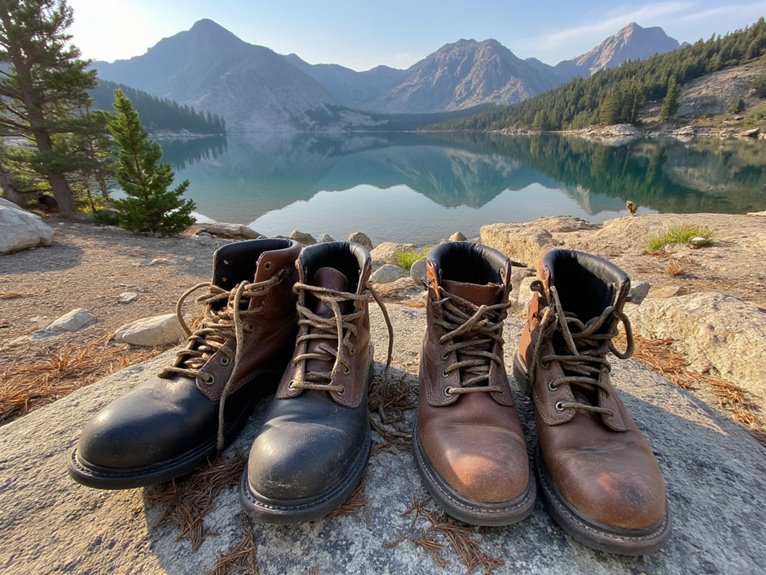Choosing Footwear for Mixed Terrain Backpacking
For mixed terrain backpacking, you’ll need footwear that balances multiple performance factors across variable conditions. Choose hiking boots or backpacking shoes with moderate stiffness (Category B or C) that provide ankle support without restricting mobility. Look for midsoles with 25-30mm thickness and dual-density EVA foam for cushioning on rocky sections while maintaining stability. Select outsoles with multidirectional tread patterns and deep lugs for traction across mud, loose scree, and established trails. The following considerations will help optimize your selection.
We are supported by our audience. When you purchase through links on our site, we may earn an affiliate commission, at no extra cost for you. Learn more. Last update on 30th December 2025 / Images from Amazon Product Advertising API.
Notable Insights
- Select backpacking shoes or lightweight hiking boots that balance durability, support, and weight for varied terrain demands.
- Choose midsoles with 25-30mm thickness and moderate firmness to provide stability on technical sections while maintaining comfort.
- Prioritize outsoles with deep, multidirectional lugs and quality rubber compounds for reliable traction across diverse surface conditions.
- Ensure proper fit with generous toe boxes and effective lacing systems to prevent blisters during long-distance hiking.
- Consider waterproof membranes and reinforced uppers for weather protection while balancing breathability and overall boot weight.
Understanding Footwear Types for Variable Trail Conditions
When you’re selecting footwear for backpacking across diverse terrain, understanding the distinct categories and their intended applications becomes essential for both performance and safety.
Trail runners excel in lightweight flexibility but sacrifice ankle support and underfoot protection. They’re best suited for established trails and experienced minimalist trekkers.
Trail runners prioritize lightweight agility over protection, making them perfect for seasoned hikers on well-maintained paths.
Approach shoes feature sticky rubber soles designed for rocky scrambling but perform poorly on soft terrain.
Backpacking shoes offer robust construction with stable cushioning, making them ideal for extended hikes with moderate loads.
Hiking boots follow Categories A through D, increasing in stiffness and terrain capability.
Lightweight hiking shoes provide superior traction compared to athletic footwear while maintaining comfort. Many hikers now prioritize weight savings when choosing between traditional boots and modern lightweight alternatives.
Footwear materials greatly impact durability and breathability. Desert conditions require shoes with sand-resistant features to prevent hot spots and maintain comfort during extended exposure to fine-grained particles.
Modern hiking footwear incorporates quick-dry technology to manage moisture effectively during extended backpacking trips.
Performance testing reveals that proper category selection directly correlates with trail success and injury prevention. Target weight for optimal performance should be under 2 pounds per pair to reduce fatigue during long-distance hiking.
Evaluating Cushioning and Midsole Technology
Your backpacking shoe’s midsole acts as the primary shock absorber between your foot and the trail, with material composition directly affecting comfort and durability over thousands of steps.
EVA foam remains the most common choice, offering lightweight cushioning that ranges from soft and plush in shoes like the On Cloudhorizon to firmer, more supportive densities found in technical hiking boots.
The drop measurement—the height difference between heel and toe—typically ranges from zero-drop platforms like the Astral Nosobo’s 20mm throughout to high-drop designs exceeding 12mm, fundamentally altering your foot strike pattern and weight distribution during extended treks.
Proper arch support within the midsole design becomes crucial for reducing foot fatigue during long-distance backpacking, with many hikers experiencing significant comfort improvements when this feature is prioritized.
Midsole Material Composition
The midsole serves as your boot’s primary shock absorption system, sitting between the outsole and your foot to cushion impact and provide structural support during long backpacking miles. Two primary materials dominate midsole construction: EVA and polyurethane.
EVA advantages include superior initial cushioning and lightweight construction. This foam material contains thousands of air-filled bubbles that compress under impact. Weight considerations favor EVA, typically weighing 20-30% less than PU alternatives.
PU benefits center on durability and consistent long term performance. Material flexibility combined with resilience prevents compression set over time.
| Material | Weight | Cushioning | Durability |
|---|---|---|---|
| EVA | Light | Excellent | Moderate |
| PU | Heavy | Good | Superior |
| TPR | Medium | Good | Good |
Cost analysis shows EVA costs less initially, while PU provides better value through extended lifespan and maintained shock absorption.
Drop and Firmness
Beyond material composition, two critical midsole characteristics—drop and firmness—fundamentally shape how your boots perform across varied backpacking terrain.
Foot drop, measured as the height difference between heel and forefoot, directly influences your gait mechanics. Zero-drop designs promote natural foot positioning and smoother rides, while higher drops of 8-12mm encourage heel striking and provide enhanced stability on steep terrain under heavy loads.
Firmness creates the foundation for cushioning effects throughout your hike. Softer midsoles using EVA or Helion superfoam deliver superior comfort but compress faster under extended use.
Dual-density designs strategically place firm support around high-stress zones while maintaining plush cushioning elsewhere. Stiffer midsoles with nylon shanks excel on technical routes, though they sacrifice some comfort for enhanced stability and protection. For rocky trails specifically, recommended midsole thickness ranges from 25-30mm to optimize the balance between ground feel and protection during prolonged use.
For backpackers targeting 8-12 hour daily wear, immediate comfort becomes essential regardless of whether you choose zero-drop barefoot designs or traditional cushioned midsoles.
Analyzing Traction and Outsole Performance
When selecting backpacking footwear, traction performance determines whether you’ll maintain confident footing or struggle with dangerous slips on challenging terrain.
Superior traction prevents dangerous falls on technical terrain, making outsole performance the most critical factor when choosing backpacking boots.
Understanding traction dynamics involves evaluating lug depth, rubber compounds, and tread patterns for your specific conditions. Deep lugs of 4mm or more excel in mud and snow but compromise outsole durability on rocky surfaces.
Moderate 4mm lugs provide balanced performance across mixed terrain. Rubber hardness creates a durability-versus-grip trade-off: softer compounds like Vibram Megagrip offer superior traction on wet rocks but wear faster than harder alternatives.
Multidirectional tread patterns channel debris away while maintaining ground contact. Flexible outsoles conform to irregular surfaces, enhancing grip on technical terrain where rigid soles would lose contact points.
Just as hiking coats require waterproof materials with sealed seams for reliable protection, quality footwear demands proven water-resistant construction to maintain performance in variable trail conditions.
Assessing Fit, Support, and Protection Features
You’ll need footwear that won’t fail when the trail gets demanding, which means focusing on two critical areas: reinforced upper construction and stability features that lock your foot securely in place.
Reinforced uppers made from full-grain leather, synthetic materials, or Gore-Tex fabrics resist abrasion and punctures from rocks, roots, and trail debris while extending your boot’s lifespan in rugged conditions.
Proper stability and lockdown systems—including heel counters, adjustable lacing, and midsole shanks—prevent internal foot movement that causes blisters and reduces your control on uneven terrain.
Reinforced Upper Construction
The construction of reinforced uppers determines how well your backpacking footwear performs across three critical areas: fit, support, and protection. Material selection directly impacts durability and comfort. Full-grain leather provides maximum abrasion resistance but requires break-in time. Nubuck leather balances flexibility with protection through its buffed surface. Split-grain leather offers lighter weight but needs synthetic reinforcement for durability.
Construction techniques integrate multiple materials strategically. Mesh panels enhance breathability in low-stress zones while leather overlays protect high-wear areas like the toe box and midfoot. Waterproof membranes such as Gore-Tex® add water resistance but reduce airflow.
Modern uppers minimize break-in through advanced stitching and material layering. The result is footwear that conforms to your foot shape while providing rigid support against ankle rolling on uneven terrain. Quality reinforced construction should include reinforced stitching and materials that maintain structural integrity across diverse trail conditions. Proper ankle support is essential for stability when navigating challenging terrain and uneven surfaces during extended backpacking trips.
Stability and Lockdown
Reinforced uppers work together with your footwear’s stability system to create a secure platform that prevents injury and enhances performance on challenging terrain.
Proper lockdown depends on how well your midfoot and heel are secured through lacing systems and internal support structures. You’ll achieve ideal ankle stability when the sole resists compression and torsional twisting in the heel counter area. Test this by manually twisting the shoe side-to-side.
A wider sole matching the upper provides greater ground contact for improved support.
Semi-curved to curved lasts promote better contouring for various foot shapes. Focus on fit adjustment during your assessment—correctly fitted shoes prevent unwanted foot movement that causes instability and blisters.
Remember that overly stiff footwear without proper fit may impede ankle joint range of motion, leading to compensatory movements that increase injury risk. Quality outsoles with deep lugs provide self-cleaning properties that maintain consistent grip across muddy and technical trail conditions.
For backpackers with wider feet, look for boots with generous toe boxes that accommodate your foot shape without creating pressure points during long-distance hiking.
Balancing Weight Against Performance Needs
Every ounce on your feet matters more than you might expect when covering miles of backcountry terrain. The weight impact becomes significant over distance—heavier boots at 975g reduce hiking speed to 2.99 mph compared to 3.17 mph with 600g shoes. This performance trade off affects your energy expenditure and overall endurance.
| Weight Category | Speed Impact | Best Use Case |
|---|---|---|
| Under 400g | Fastest pace, lowest energy cost | Smooth trails, light loads |
| 350-450g | Moderate speed with good support | Mixed terrain, moderate loads |
| 500g+ | Slower pace, higher energy drain | Technical terrain, heavy packs |
Your terrain and pack weight determine the ideal balance. Technical trails with heavy loads justify heavier boots despite speed penalties, while moderate terrain allows lighter footwear for better efficiency. Lightweight hiking shoes specifically reduce fatigue on long trails, making them particularly valuable for extended backcountry trips. For optimal performance, target lightweight designs under 10 ounces with aggressive lugs that provide the traction needed without unnecessary bulk.
Selecting Weatherproofing and Durability Options
When selecting backpacking footwear, weatherproofing and durability features directly impact your comfort and safety across varying trail conditions.
Waterproof technologies like Gore-Tex and proprietary membranes such as Oboz B-DRY provide reliable moisture protection while maintaining breathability. These membranes reduce breathability compared to non-waterproof models but prevent wet feet during stream crossings.
Material selection markedly affects longevity. Durable uppers use abrasion-resistant leather or reinforced textiles with synthetic overlays to withstand trail debris. Quality stitching and bonding determine long-term performance under hiking stress. Reinforced toe caps guard against rock strikes.
Consider flood tolerance levels carefully. Some waterproof boots only protect up to below-ankle depth. Gusseted tongues and quality seam sealing reduce water intrusion.
Balance protection needs against added weight from waterproof construction. Additionally, look for anti-slip outsoles with deep traction patterns that provide superior grip on wet rocks and icy trail sections.
Many hikers report that seam-sealed construction enhances overall waterproof capabilities, proving particularly effective when encountering mud and snow conditions on extended trails.
On a final note
You’ve analyzed the critical factors for mixed terrain footwear selection. Your choice depends on balancing competing priorities: cushioning versus ground feel, traction versus durability, protection versus weight savings. Consider your specific trail conditions, pack weight, and personal biomechanics when making your final decision. Test multiple options with loaded packs before committing. Remember that no single boot excels in every category—you’re optimizing for your most frequent terrain challenges and environmental conditions.

